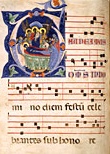

Examples of art of the Middle Ages:
German (Lower Saxony, Brunswick, c. 1040), Portable Altar and Ceremonial Crosses of Countess Gertrude of Holland and Count Liudolf Brunon, from the Guelph Treasure, Cleveland Museum of Art. See altar.

Gerona Bible Master, Bologna, Italy, Gradual,
Proper and Common of Saints (folio
84 verso in Manuscript
526), c. 1285, tempera on vellum, one of 290 folios,
51.5 x 35.5 cm (20 1/4 x 14 inches), Musei Civici d'Arte Antica,
Bologna. Black marks arranged on the horizontal
lines ("staff")
displayed here exemplify the system of musical
notation used in Italy during much of the Middle Ages. The Latin
text (or lyric)
opens with "Gaudeamus," meaning "Let us rejoice."
The initial letter "G" is historiated
in late Byzantine
style. This "gradual"
is one of a set of three that together comprise the sung portions
of the Mass for the entire church year.

Giotto di Bondone (Italian, Florentine, 1266/76-1337),
The Epiphany, possibly c. 1320, tempera
on wood panel,
gold ground,
17 3/4 x 17 1/4 inches (45.1 x 43.8 cm), Metropolitan Museum
of Art, NY. (On the Met's page, you can enlarge any detail.)

Simone Martini (Italian, c. 1284-1344), Madonna from the Annunciation, 1340-1344,
tempera on wood
panel, 12 x 8 1/2 inches (30.5
x 21.5 cm), State Hermitage Museum, St. Petersburg, Russia.
Attributed to Bernardo Daddi (Italian, active c.1290-1349), A Crowned Virgin Martyr (St. Catherine of Alexandria), c.1340, tempera on wood panel, 24 1/4 x 12 inches, Legion of Honor, San Francisco.

Jan van Eyck (Netherlandish, c. 1395 [active
by 1422] - 1441) and Workshop Assistant, The Crucifixion and the Last Judgment,
c. 1430, oil on canvas,
transferred from wood, each 22
1/4 x 7 2/3 inches (56.5 x 19.7 cm), Metropolitan Museum of Art,
NY. (On the Met's page, you can enlarge any detail.) See diptych.
Rogier van der Weyden (Flemish, 1400-1464), The Deposition from the Cross, c. 1435, wood, (220 x 262 cm), Prado Museum, Madrid.

Fra Filippo Lippi (Italian, Florentine, c.
1406-1469), Portrait of a Man and Woman at a Casement,
c. 1440, tempera on wood
panel, 25 1/4 x 16 1/2 inches (64.1
x 41.9 cm), Metropolitan Museum of Art, NY. (On the Met's page,
you can enlarge any detail.)

Robert Campin (Master of Flemalle) (Netherlandish,
active, 1406-1444), Madonna and Child before a Fireplace,
oil on panel,
13 x 9 1/2 inches (34.3 x 24.5 cm), Hermitage Museum, St. Petersburg,
Russia.

Robert Campin (Master of Flemalle), The Holy Trinity (Throne of God), oil on panel,
13 x 9 inches (34.3 x 24.5 cm), Hermitage Museum, St. Petersburg,
Russia.
Hieronymus Van Aeken Bosch (Flemish, 1450-1516)

Count de Meurs, (Netherlandish), Drawings in a Letter, 1493, Library of
Zutphen, Netherlands. Manuscripts dating back to the Middle Ages
often used sequential
pictures accompanied by
text, or sometimes even used text-balloons
for captions as in this
example. See cartoon
and Dutch art.
Also see Gothic, labyrinth, masterpiece, paraph, and plaque.
https://inform.quest/_art